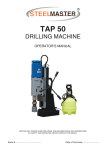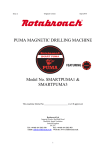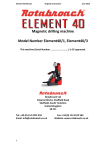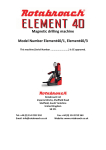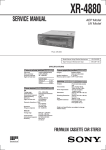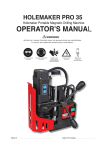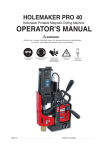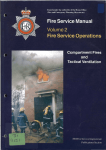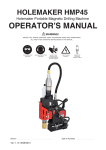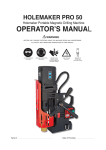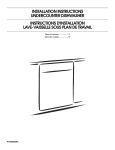Download TAP30 User Manual.indd - Industrial Tool and Machinery Sales
Transcript
® TAP 30 DRILLING MACHINE OPERATOR’S MANUAL BEFORE USE, ENSURE EVERYONE USING THIS MACHINE READS AND UNDERSTANDS ALL SAFETY AND OPERATING INSTRUCTIONS IN THIS MANUAL . Serial #............................................ Date of Purchase............................ HOLEMAKER TAP 30 DRILLING MACHINE IMPORTED & DISTRIBUTED BY INDUSTRIAL TOOL & MACHINERY SALES 18 BUSINESS ST YATALA QLD 4207 AUSTRALIA T F E W 07 3287 1114 07 3287 1115 [email protected] www.industrialtool.com.au WARRANTY TERMS In addition to any warranties or conditions implied by applicable Statute or Regulations, Industrial Tool & Machinery Sales warrants all of it’s products against defective workmanship and faulty materials for a period of twelve (12) months from the date of purchase, unless otherwise stated. At our option we will repair or replace, free of charge, any item on the condition that: • The complete machine or tool is returned, freight prepaid to ITM or one of it’s authorised service agents as directed by ITM, and is found to have a material or constructional defect. • The machine or tool has not been subject to misuse, neglect or damage by accident. • The fault is not a result of normal “wear and tear”. • Written permission has been received from ITM prior to commencement of repair. • Repairs, tampering or modification carried out by unauthorised personnel will void all warranty. • Consumable items such as cutting tools, pilot pins, saw blades, grinding wheels etc. are NOT covered by warranty. Our goods come with guarantees which cannot be excluded under the Australian Consumer Law. You are entitled to replacement or refund for a major failure and to compensation for other reasonably foreseeable loss or damage. You are also entitled to have the goods repaired or replaced if the goods fail to be of acceptable quality and the failure does not amount to a major failure. 2 HOLEMAKER TAP 30 DRILLING MACHINE TABLE OF CONTENTS 1. 1.1. 1.2. 1.3 1.4 1.5 Safety Instructions Read And Save All Instructions For Future Reference Safety Requirements Special Safety Requirements Specifications Package Contents -4-4-4-6-7-7- 2. 2.1. 2.2. 2.3. 2.4. 2.5. 2.6. 2.7. 2.8. 2.9. Operation Operating Tips Stopping and Starting the Machine Speed Control Gear Selection Per Cutter Sizes Use Of Cutting Fluid Mounting Of Cutters Adjustment Of The Slide Tips For Keeping Your Machine In Correct Working Order Extension Cable Selection -8-8-8-9-9-9- 10 - 10 - 11 - 13 - 3. Solutions For Drilling Problems - 13 - 4. Trouble Shooting - 15 - 5. Parts Breakdown - 16 - 6. Electrical Circuit - 20 - 3 SAFETY INSTRUCTIONS READ OPERATOR’S MANUAL BEFORE YOU START TO WORK WITH THE MACHINE. 1. Safety Instructions The HMTAP30 Magnetic Base Drilling Machine should be used only to applications stated in the manual. Using in other applications may lead to personal injury and machine damage. 1.1. Read And Save All Instructions For Future Reference When using electric tools, basic safety precautions should always be followed to reduce risk of fire, electric shock and personal injury. 1.2. Safety Requirements 1. 2. Keep Work Area Clean Consider Work Area Environment Do not expose power tools to rain. Do not use power tools in damp or wet locations. Keep work areas well lit. Do not use tool in presence of flammable liquids or gases. 3. Guard against Electric Shock Prevent body contact with grounded surfaces. For example: pipes, radiators, ranges, refrigerator enclosures. 4. Keep Children Away Do not let visitors contact tool or extension cord. 5. Store Idle Tools When not in use, tools should be stored in dry and high or locked-up place, out of reach of children. 6. Do Not Force Tool It will do the job better and safer at the rate for which it was intended. 7. Use Right Tool Do not force small tool or attachment to do the job of a heavy-duty tool. Do not use tool for purpose not intended - for example; do not use a circular saw for cutting tree limbs or logs. 8. Dress Properly Do not wear loose clothing or jewellery; they can be caught in moving parts. Rubber gloves and non-skid footwear are recommended when working outdoors. Wear protective hair covering to contain long hair. 9. Use Safety Glasses Also use face or dust mask if cutting operation is dusty. 10. Do Not Abuse Electrical Cord Never carry tool by cord or yank it to disconnect from receptacle. Keep cord from heat, oil and sharp edges. 11. Secure Work 4 SAFETY INSTRUCTIONS 12. 13. 14. 15. 16. 17. 18. 19. Use clamps or a vice to hold work. It is safer than using your hand and it frees both hands to operate tool. Do Not Overreach Keep proper footing and balance at all times. Maintain Tools with Care Keep tools sharp and clean for better and safer performance. Follow instructions for lubricating and changing accessories. Inspect tool cords periodically and if damaged, have repaired by authorized service facility. Inspect extension cords periodically and replace if damaged. Keep handles dry, clean and free from oil and grease. Disconnect Tools Unplug when not in use, before servicing and when changing accessories, such as blades, bits and cutters. Remove Adjusting Keys and Wrenches Form habit of checking to see that keys and adjusting wrenches are removed from tool before turning it on. Avoid Unintentional Starting Do not carry plugged-in tool with fingers on switches. Be sure switches are off when plugging in. Outdoor Use Extension Cords When tool is used outdoors, use only extension cords intended for use outdoors and so marked. Stay Alert (Do not use when taking medications that may cause drowsiness.) Watch what you are doing. Use common sense. Do not operate tool when you are tired. Check Damaged Parts Before further use of the tool, a guard or other part that is damaged should be carefully checked to determine that it operates properly and perform its intended function. Check for alignment of moving parts, binding of moving parts, breakage of parts, mounting and any other conditions that may effect its operation. A guard or other part that is damaged should be properly repaired or replaced by an authorized service centre. Do not use this tool if switches do not turn it on and off. Have defective switches replaced by authorized service centre. WARNING! SAFETY RULES MUST BE CLOSELY OBSERVED. 5 SAFETY INSTRUCTIONS 1.3. Special Safety Requirements 1. 2. 3. 4. 5. 6. 7. 8. 9. 10. 11. 12. 13. 14. Read and follow operator’s manual thoroughly. If you cannot locate your operator’s manual contact ITM (www.industrialtool.com.au) for an additional FREE copy. DO NOT touch rotating cutter or parts. Always stop machine completely and unplug from power source before changing cutters, cleaning clips, refilling lubrication or performing adjustments. Never wear loose clothing or gloves when working near cutting area or machine arbor. Always wear eye protection. Any tool can shatter. Always use safety chain or strap provided with machine. Always use proper tooling, keep cutters securely fastened. DO NOT use dull or broken cutters. Beware of ejected slugs at end of cut, they become HOT during the cut. Magnet will not hold properly on thin materials under 3/8” (9.5mm), rough or dirty surfaces. Keep all safety features functioning and working properly. Keep bottom of magnet burr free and clear of chips and debris. To reduce the risk of electrical shock, DO NOT remove or alter electrical panels or use machine in damp areas. Use only authorized service centres for repairs. HMTAP30 drilling machine must be connected to “protected power source” which is properly grounded. Improperly connecting the grounding wire can result in the risk of electrical shock. Check with a qualified electrician if you are in doubt as to whether the outlet is properly grounded. Do not modify the plug provided with the tool. Never remove the grounding prong from the plug. Do not use tool if the cord or plug is damaged, have it repaired before using. If the plug will not fit the outlet, have a proper outlet installed by a qualified electrician. The TAP30 must be plugged into an appropriate outlet, properly installed and grounded in accordance with all codes and ordinances. If in doubt of proper grounding, call a qualified electrician. 6 SAFETY INSTRUCTIONS 1.4. Specifications Motor Unit Voltages Normal Full Load Output Magnet Size Magnet Force At 20°C With 25mm Plate Thickness. The use on any material less than 25mm thick will progressively reduce the magnetic performance. If possible, substitute material should be positioned under the magnet and work piece to equate to a suitable material thickness. If this is not possible, an alternative secure method of restraining the machine MUST be used. 230V / 60Hz 2000W 210 x 105 x 70 mm 1850kgf Overall Dimensions Height - maximum extended Height - minimum Width (including Hand wheel) Length Overall Stroke Net Weight Maximum hand/arm vibration magnitude (measured at handle during operation in accordance with ISO5349, using a 22mm cutter through 13mm MS plate) Estimate of likely daily vibration exposure. Operation 30 holes @ 2 minute/hole. Average noise level during cutting at operators ear position. 750mm 490mm 205mm 300mm 260mm 26.5kg 0.82m/s2 0.29m/s2 A(8) 89dB(A) 1.5. Package Contents • • • • • • • Operator’s Manual Coolant Bottle Safety Chain Arbor--MT3 (3/4” bore) Drill Drift 4mm Hexagon Key 3mm Hexagon Key 7 OPERATION 2. Operation 2.1. Operating Tips • • • • • Keep the inside of the cutter clear of swarf. It restricts the operating depth of the cutter. Ensure that the coolant bottle contains sufficient cutting oil to complete the required operating duration. Refill as required. Occasionally depress the pilot to ensure cutting fluid is being correctly metered. Apply light pressure when commencing to cut a hole until the cutter is introduced into the work surface. Excessive pressure is undesirable, it does not increase the speed of penetration. Always ensure that the slug has been ejected from the previous hole before commencing to cut the next. G G (Right) • • • (Wrong) Always cut overlapping holes as illustrated above –do not use excessive pressure and ensure cutting fluid is reaching teeth of the cutter. If the slug sticks in the cutter, move the machine to a flat surface, switch on the magnet and gently bring the cutter down to make contact with the surface. This will usually straighten a cocked slug and allow it to eject normally. Cutter breakage is usually caused by insecure anchorage and a loosely fitting slide. (Refer to routine maintenance instructions). 2.2. Stopping & Starting The Machine Before starting the motor, always make sure to turn on the magnetic switch first. When the magnet is activated, the motor can be started with start button. Stopping the motor must always be done with the stop switch. Never stop the machine with the main current / magnetic switch. It is dangerous, and can also cause damage to the electronics of the machine. 8 OPERATION 2.3. Speed Control The machines are equipped with a mechanical four-speed gearbox. Select the required speed by pressing-in, shifting and engaging. Change the speed only when the machine is not running, and support the gear-changing by slightly rotating the spindle. Position 1 2 3 4 RPM (no load) 45 - 90 rpm 90 - 160 rpm 125 - 400 rpm 300 - 570 In load condition each gear has 65~75% efficiency defendant on working situations. So following RPM is expected per each gear. 1st : 58 ~ 68 2nd : 104 ~ 120 3rd : 215 ~ 248 4th : 384 ~ 425 G 1st 45-90 1 st 2nd 90-160 2 nd 3rd 215-400 4th 300-570G 3 rd 4 th G 2.4. Gear Selection Per Cutter Sizes In case of cutting normal mild steel with cutters under 35mm dia. 2nd gear is recommendable. And for cutters over 40mm dia. 1st gear should be selected. For cutters around 36 ~ 39 mm dia. it depends on situation. Specially the material to be cut is very important. 9 OPERATION 2.5. Use Of Cutting Fluid The use of cutting fluids is absolutely necessary when drilling with steel cutters. Always use the correct cutting oil intended for use. Other oils may provide insufficient lubrication under different temperatures. When cutting with hard and difficult materials and a deep hole, it may be advantageous to provide cutting oil under pressure. For TAP30 it is recommended to use a pressure can instead of a regular oil tank. The pressure canister has a hose with a quick coupling and the valve on the pressure canister can be used to regulate the oil supply. Cutting oil (or paste) must always be supplied through the centre of the cutter so that the oil goes inside out during drilling. Application of cutting oil outside the cutter will not provide the necessary lubrication inside the cutter and cause a faster heating of the plug formed in the cutter. The heat will cause the plug to expand and often result in a broken cutter. 2.6. Mounting Of Cutters The machine has been made to accept MT3 Arbor. The following procedure is to be used when mounting cutters: • Take appropriate pilot and place through hole in shank of cutter. • Insert shank of cutter into 3/4” dia. bore of arbor, ensuring alignment of two drive flats with socket screws. • Arbor Selection - For cutters of 11mm ~ 60mm dia. : 3/4” dia. bore of arbor. - For cutters over 60mm dia. : 1 1/4” dia. bore of arbor. • Tighten both screws using hexagon key. 2.7. Adjustment Of The Slide For the machine to work well, it is essential that the slide that controls the core feeding movements, can be moved in an easy and controlled way without lateral movement or vibration. Periodic adjustment of the slide is performed as follows: • • • • • 10 Stand the machine upwards on a steel plate in a vertical position and raise the slide up to the highest possible position by turning the capastan arm. Clean the slide and apply thin machine oil on the sliding surfaces. Loosen the 2 screws that hold the bearing bracket and lower the slide to the lowest position. Starting by adjusting the middle screws. Then adjust all the screws gently until slight resistance is achieved. Move the slide up and down a few times to test the movement. Make the necessary adjustments. Make sure all screws are equally tightened and ensure that the slide moves up and down without any sideways movement. OPERATION 2.8. Tips For Keeping Your Machine In Correct Working Order In order to ‘get the best life’ out of your magnetic drill machine, always keep in good working order. A well maintained machine is a happy machine. A number of items must always be checked on magnetic drilling machines. Always before starting any job, make sure the machine is in good working order and that there are no damaged or loose parts. Any loose parts must be tightened. Before proceeding with any maintenance work, be certain that the power supply is disconnected. Visual check on machine for damage Operation of machine Check of magnetic base Check of brush wear Check Alignment of machine Check of grease Check armature Everyday X Once a Week Once a Month X X X X X X Visually check the machine for damage. Machine must be checked before operation for any signs of damage that will affect the operation of the machine. Particular notice must be taken of the mains cable, if the machine appears to be damaged it should not be used failure to do so may cause injury or death. Check operation of the machine. The machines operation must be checked to ensure that all components are working correctly. Machines Carbon Brushes. The Machines Brushes should be checked to make sure there is no abnormal wear present. This should be checked at least once a week if used frequently. If the brush has worn more than 2/3 the original length the brushes should be changed. Failure to do so may cause damage to the machine. Machines Magnetic base. Before every operation the magnetic base should be checked to make sure that the base is flat and there is no damage present. An uneven magnet base will cause the magnet not to hold as efficiently and may cause injury to the operator. Adjustment of slide and bearing bracket Alignment. An essential requirement of the machine is that the slide can move in a smooth and controlled manner, free of lateral movement and vibration. This situation can be maintained by periodic adjustment of the slide and is accomplished. 11 OPERATION Check machines grease. The gearbox grease should be checked once a month to ensure all moving components are covered to prevent wear. The grease should be changed at least once a year to ensure you gain the best from the machine. Check Armature of the machine. This should be checked at least 1 per month to see that there are visual signs of damage to the body or to the commutator. Some signs of wear will be seen on the commutator over a period of time. This is normal as this is the part that comes in contact with the brushes but any signs of abnormal damage and the part should be replaced. The motor on this machine has brushes. The brushes should be checked regularly to detect any abnormal wear. With regular use brushes should be checked at least once per week. Brushes that are worn more than 2/3 of its normal length, should be replaced. Failure to do so may cause motor damage or repairs of larger scope. The brushes on the left is just an illustration and therefore differ in appearance. With regular use, the armature should be checked at least once per month. Look for visible damage or wear to the armature body and the commutator (commutator are brass plates which the brushes are touching). The brushes will naturally wear on the commutator. This is normal. Look for damages in plates that have lifted or loose brass boards. Change the aramature if damage or excessive wear is found. If much coal dust is found on the commutator, use compressed air to low clean. The armature on the left is just an illustration and therefore may differ in appearance. 12 OPERATION 2.9. Extension Cable Selection The machines are factory fitted with a 2 metre length of cable having three conductors 1.5mm² LIVE, NEUTRAL and EARTH. If it becomes necessary to fit an extension cable from the power source, care must be taken in using a cable of adequate capacity. Failure to do so will result in a loss of traction by the magnet and a reduction of power from the motor. Assuming a normal AC supply of the correct voltage, it is recommended that the following extension lengths shall not be exceeded: For 230v supply: 26metres of 3 core x 1.5mm² or 17metres of 3 core x 1.0mm² 3.0. Solutions For Drilling Problems 13 SOLUTIONS FOR DRILLING PROBLEMS 14 TROUBLE SHOOTING Neither Magnet or Motor is working • • • • • • The magnetic switch is not powered Damaged or defective wiring Damaged or defective fuse Faulty magnetic switch Defective control box Faulty power supply Magnet is active, but motor does not turn • • • • • • Damaged or defective wiring Brushes are stuck or too worn Faulty magnetic switch Defective stop/start switch Defective control box Defective armature or field Motor runs but magnet is not getting activated • • Faulty magnet Defective control box The cutter breaks and/or making holes larger than the size of the cutter • • • • • Clearance in the machines controls and/or slide function Bent or sprung shaft Curved centre point Faulty or insufficient magnetic holding power Contact between the magnet and workpiece The motor is pulling heavily and/or stops • • • Bent or warped shaft Bearing bracket adjusted incorrectly Contamination between spindle and bearing bracket Noise in the motor/gearbox • • • Worn bearing between gearbox and motor Damaged drives in the gearbox Low amount of grease in the gearbox The motor scores, brush fires and little or no power • • • Damaged Armature Damaged Field Damaged or Worn Brushes The motor does not start or stop • • • • Damaged or defective wiring Contaminated reader Defective or loose magnet in reader for speed control Damaged or defective brushes Heavy feed motion • • • Slide adjustments are tightened too hard The slides, sliding surfaces are too dry Shaft/Rack are contaminated Magnetic holding power is too • low • • • • Damaged or deceptive wiring The work area/surface is not clean and/or dry The work area/surface has poor magnetic ability The work area/surface is not flat The work area/surface is too thin (thinner than 10mm) Motor only runs at maximum RPM • • Damaged or defective wiring Faulty control box The operator receives an electric shock • • • Damaged or defective wiring Faulty magnet The motor is heavily polluted Fuse blows when magnet is activated • • • • Damaged or defective wiring Faulty magnet switch Defective control box Faulty magnet Fuse blows when starting the motor • • • • • Damaged or defective wiring Defective armature and/or field Motors running too fast Worn brushes Defective control box 15 PARTS BREAKDOWN G G G +7$33$57 G G 16 12G 3$5712G G 3$57 1$0(G 4 W\G G +7$3$G G 61$35,1*57:G G G +7$3$G G %($5,1*B.<.==G G G +7$3$G G 63,1'/(G G G +7$3$G G +(;62&.(7+($'6&5(:0/G G G +7$3$G G *($5%2;G G G +7$3$G G *($5&+$1*(5$66 <G G G +7$3$G G 1,''/(%($5,1*.<.=G G G +7$3$G G 7+,5'3,1,21G G G +7$3$G G 7+,5'*($5G G PARTS BREAKDOWN 12G 3$5712G G 3$57 1$0(G 4 W\G G +7$3$G G 1,''/(%($5,1*.<.=G G G +7$3$G G %($5,1*171//8G G G +7$3$G G 61$35,1*67:G G G +7$3$G G 0$,1*($5G G G +7$3$G G 61$35,1*57:G G G +7$3$G G .(<;;;5G G G +7$3$G G 3,13,/G G G +7$3$G G %($5,1*.%&==G G G +7$3$G G 6(&21'3,1,21G G G +7$3$G G .(<;;;5G G G +7$3$G G 6(&21'*($5G G G +7$3$G G %($5,1*1.G G G +7$3$G G ,11(5&29(5G G G +7$3$G G *($5&283/,1*$G G G +7$3$G G %($5,1*171//8G G G +7$3$G G 61$35,1*67:G G G +7$3$G G %($5,1*+.9G G G +7$3$G G ),5673,1,21G G G +7$3$G G ),567*($5.(<G G G +7$3$G G +.9),567*($5 G G G +7$3$G G 61$35,1*67:G G G +7$3$G G %($5,1*.%&==G G G +7$3$G G *($5&283/,1*%G G G +7$3$G G $50$785()$1G G G +7$3$G G )$1%86+,1*G G G +7$3$G G $50$785($66 <G G G +7$3$G G $50$785(%86+,1*G G G +7$3$G G %($5,1*171==&G G G +7$3$G G +(;62&.(7+($'6&5(:0/G G G +7$3$G G 67$725G G G +7$3$G G +286,1*G G GG +7$3$G G &$5%21%586++2/'(5$66 <G G G +7$3$G G +286,1*&$3G G G +7$3$G G +(;62&.(7+($'6&5(:0/G G G +7$3$G G +(;62&.(7+($'6&5(:0/G G G +7$3$G G 3*&29(5G G G +7$3$G G 0$*1(75,1*3&%G G G +7$3$G G 0$*1(75,1*G G 17 PARTS BREAKDOWN G G G +7$33$57 G G 18 12G 3$5712G G 3$57 1$0(G 4 W\G G +7$3%G G 02725*($5%2;$66 <G G G +7$3%G G +(;62&.(7+($'6&5(:0/G G G +7$3%G G +(;62&.(7+($'6&5(:0/G G G +7$3%G G *,%675,3G G G +7$3%G G 1870G G G +7$3%G G 25,1*$66(0%/('6723%2/7G G G +7$3%G G 6/,'(G G G +7$3%G G 62&.(76(76&5(:0/G G G +7$3%G G 3*&29(5G G G +7$3%G G :,5(+26(G G G +7$3%G G 5$&.*($5G G G +7$3%G G 6/,'(%$5G G PARTS BREAKDOWN G +7$3%G G &22/$17+$1*(5G G G +7$3%G G +(;62&.(7+($'6&5(:0/G G G +7$3%G G &22/$177$1.$66 <G G G +7$3%G G +$1'/($66 <G G G +7$3%G G +$1'/(3,1,21G G G +7$3%G G %86+,1* G G G +7$3%G G +$1'/(B&2//$5 G G G +7$3%G G +(;62&.(7+($'6&5(:0/G G G +7$3%G G 3$1+($'('6&5(:0/ G G G +7$3%G G :$51,1*3$1(/ G G G +7$3%G G 0$,13&%G G G +7$3%G G 6&5(:0/ G G G +7$3%G G &$%7</(&$%/($66 < G G G +7$3%G G +(;62&.(7+($'6&5(:0/G G G +7$3%G G +(;62&.(7+($'6&5(:0/G G G +7$3%G G &$%/(*5$1'$66 < G G G +7$3%G G (/(&7520$*1(7 G G G +7$3%G G 3$1+($'('6&5(:0/G G G +7$3%G G &21752/3$1(/ G G G +7$3%G G 0$,1)5$0(G G G +7$3%G G $5%256833257(5G G G +7$3%G G +(;62&.(7+($'6&5(:0/G G G G 19 ELECTRICAL CIRCUIT G G G G G G G G G G G G G G G G G G G G G WARNING - THIS APPLIANCE MUST BE EARTHED!G G G Insulation Resistance TestG :LWKWKHPDJQHWVZLWFKLQWKH21SRVLWLRQDSSO\DYROWDJHRINYEHWZHHQWKHOLYH FRQQHFWLRQRQWKHPDLQVSOXJDQGWKHIUDPHRIWKHPDFKLQHIRUDGXUDWLRQRI VHFRQGV7KHUHDGLQJREWDLQHGVKRXOGQRWIDOOEHORZLQILQLW\6KRXOGDIDXOWEH LQGLFDWHGLWOWUVDGHQWPFCPFTGEVKHKGFG 20




















